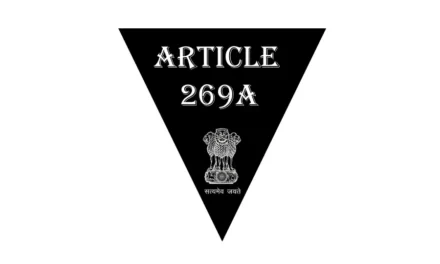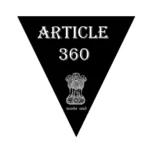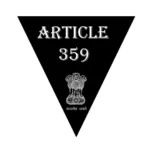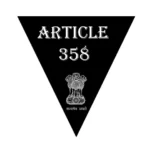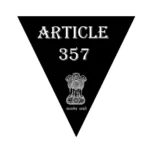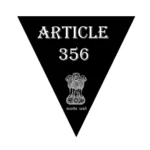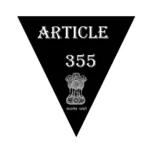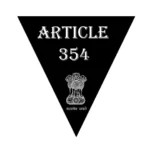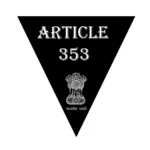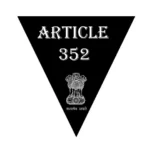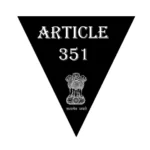यह लेख Article 168 (अनुच्छेद 168) का यथारूप संकलन है। आप इस मूल अनुच्छेद का हिन्दी और इंग्लिश दोनों संस्करण पढ़ सकते हैं। आप इसे अच्छी तरह से समझ सके इसीलिए इसकी व्याख्या भी नीचे दी गई है आप उसे जरूर पढ़ें, और MCQs भी सॉल्व करें।
| Bell आइकॉन पर क्लिक करके हमारे नोटिफ़िकेशन सर्विस को Allow कर दें ताकि आपको हरेक नए लेख की सूचना आसानी से प्राप्त हो जाए। साथ ही नीचे दिए गए हमारे सोशल मीडिया हैंडल से जुड़ जाएँ और नवीनतम विचार-विमर्श का हिस्सा बनें। खासकर के टेलीग्राम और यूट्यूब से जरूर जुड़ जाएं; |

📜 अनुच्छेद 168 (Article 168) – Original
| भाग 6 “राज्य” [अध्याय 3 — राज्य का विधान मंडल] [साधारण] |
|---|
| 168. राज्यों के विधान-मंडलों का गठन — (1) प्रत्येक राज्य के लिए एक विधान- मंडल होगा जो राज्यपाल और — (क) 1*** 2[आध्रं प्रदेश], बिहार, 3*** 4[मध्य प्रदेश] 5*** 6[महाराष्ट्र], 7[कनार्टक] 8*** 9*** [10[तमिलनाडु, तेलंगाना] 11[और उत्तर प्रदेश] राज्यों में दो सदनों से; (ख) अन्य राज्यों में एक सदन से, मिलकर बनेगा। (2) जहां किसी राज्य के विधान-मंडल के दो सदन हैं वहां एक का नाम विधान परिषद् और दूसरे का नाम विधान सभा होगा और जहां केवल एक सदन है वहां उसका नाम विधान सभा होगा।] ================= 1. “आंध्र प्रदेश” शब्दों का आंध्र प्रदेश विधान परिषद् (उत्सादन) अधिनियम, 1985 (1985 का 34) की धारा 4 द्वारा (1-6-1985 से) लोप किया गया। 2. आंध्र प्रदेश विधान परिषद् अधिनियम, 2005 (2006 का 1) की धारा 3 द्वारा (30-3-2007 से) अंतःस्थापित। 3. मुंबई पुनर्गठन अधिनियम, 1960 (1960 का 11) का धारा 20 द्वारा (1-5-1960 से) “मुंबई” शब्द का लोप किया गया। 4. इस उपखंड में “मध्य प्रदेश” शब्दों के अंतःस्थापन के लिए संविधान (सातवां संशोधन) अधिनियम, 1956 की धारा 8(2) के अधीन कोई तारीख नियत नहीं की गई है। 5. तमिलनाडु विधान परिषद् (उत्सादन) अधिनियम, 1986 (1986 का 40) की धारा 4 द्वारा (1-11-1986 से) “तमिलनाडु” शब्द का लोप किया गया। 6. मुंबई पुनर्गठन अधिनियम, 1960 (1960 का 11) की धारा 20 द्वारा (1-5-1960 से) अंतःस्थापित। 7. मैसूर राज्य (नाम परिवर्तन) अधिनियम, 1973 (1973 का 31) की धारा 4 द्वारा (1-11-1973 से) ‘मैसूर” के स्थान पर प्रतिस्थापित, जिसे संविधान (सातवां संशोधन) अधिनियम, 1956 की धारा 8(1) द्वारा (1-11-1956 से) अंतःस्थापित किया गया था। 8. पंजाब विधान परिषद् (उत्सादन) अधिनियम, 1969 (1969 का 46) की धारा 4 द्वारा (7-1-1970 से) “पंजाब” शब्द का लोप किया गया। 9. तमिलनाडु विधान परिषद् अधिनियम, 2010 (2010 का 16) का धारा 3 द्वारा (तारीख बाद में अधिसूचित की जाएगी) अंतःस्थापित। 10. आंध्र प्रदेश पुनर्गठन अधिनियम, 2014 (2014 का 6) की धारा 56 द्वारा (1-6-2014 से) “तमिलनाडु” के स्थान पर प्रतिस्थापित। 11. बंगाल विधान परिषद् (उत्सादन) अधिनियम, 1969 (1969 का 20) की धारा 4 द्वारा (1-1-1969 से) “उत्तर प्रदेश और पश्चिमी बंगाल” के स्थान पर प्रतिस्थापित। |
| Part VI “State” [CHAPTER III — THE State Legislature] [General] |
|---|
| 168. Constitution of Legislatures in States — (1) For every State there shall be a Legislature which shall consist of the Governor, and— (a) in the States of 1* 2 [Andhra Pradesh], Bihar, 3* 4[Madhya Pradesh], 5 *** 6 [Maharashtra], 7[Karnataka], 8 *** 9[10 [Tamil Nadu, Telangana]] 11[and Uttar Pradesh], two Houses; (b) in other States, one House. (2) Where there are two Houses of the Legislature of a State, one shall be known as the Legislative Council and the other as the Legislative Assembly, and where there is only one House, it shall be known as the Legislative Assembly. ====================== 1. The words “Andhra Pradesh,” omitted by the Andhra Pradesh Legislative Council (Abolition) Act, 1985 (34 of 1985), s. 4 (w.e.f. 1-6-1985). 2 . Ins. by the Andhra Pradesh Legislative Council Act, 2005 (1 of 2006), s. 3 (w.e.f. 30-3-2007). 3. The word “Bombay” omitted by the Bombay Reorganisation Act, 1960 (11 of 1960) s. 20 (w.e.f. 1-5-1960). 4. Ins. by the Constitution (Seventh Amendment) Act, 1956, s. 8 (date to be notified). 5. The words “Tamil Nadu,” omitted by the Tamil Nadu Legislative Council (Abolition) Act, 1986 (40 of 1986), s. 4 (w.e.f. 1-11-1986). 6. Ins. by the Bombay Reorganisation Act, 1960 (11 of 1960), s. 20 (w.e.f. 1-5-1960). 7. Subs. by the Mysore State (Alteration of Name) Act, 1973 (31 of 1973), s. 4, for “Mysore” (w.e.f. 1-11-1973), which was inserted by the Constitution (Seventh Amendment) Act, 1956, s. 8(1) (w.e.f. 1-11-1956). 8. The word, “Punjab,” omitted by the Punjab Legislative Council (Abolition) Act, 1969 (46 of 1969), s. 4 (w.e.f. 7-1-1970). 9. Ins. by the Tamil Nadu Legislative Council Act, 2010 (16 of 2010), s. 3 (date to be notified). 10. Subs. by the Andhra Pradesh Reorganisation Act, 2014 (6 of 2014), s. 96, for “Tamil Nadu” (w.e.f. 2-6-2014). 11. Subs. by the West Bengal Legislative Council (Abolition) Act, 1969 (20 of 1969), s. 4 for “Uttar Pradesh and West Bengal” (w.e.f. 1-8-1969). |
🔍 Article 168 Explanation in Hindi
भारतीय संविधान का भाग 6, अनुच्छेद 152 से लेकर अनुच्छेद 237 तक कुल 6 अध्यायों (Chapters) में विस्तारित है (जिसे कि आप नीचे टेबल में देख सकते हैं)।
| Chapters | Title | Articles |
|---|---|---|
| I | साधारण (General) | Article 152 |
| II | कार्यपालिका (The Executive) | Article 153 – 167 |
| III | राज्य का विधान मंडल (The State Legislature) | Article 168 – 212 |
| IV | राज्यपाल की विधायी शक्ति (Legislative Power of the Governor) | Article 213 |
| V | राज्यों के उच्च न्यायालय (The High Courts in the States) | Article 214 – 232 |
| VI | अधीनस्थ न्यायालय (Subordinate Courts) | Article 233 – 237 |
जैसा कि आप ऊपर देख सकते हैं, इस भाग के अध्याय 3 का नाम है “राज्य का विधान मंडल (The State Legislature)” और इसका विस्तार अनुच्छेद 158 से लेकर अनुच्छेद 212 तक है।
इस अध्याय को आठ उप-अध्यायों (sub-chapters) में बांटा गया है, जिसे कि आप नीचे चार्ट में देख सकते हैं;
| Chapter 3 [Sub-Chapters] | Articles |
|---|---|
| साधारण (General) | Article 168 – 177 |
| राज्य के विधान मण्डल के अधिकारी (Officers of the State Legislature) | Article 178 – 187 |
| कार्य संचालन (Conduct of Business) | Article 188 – 189 |
| सदस्यों की निरर्हताएं (Disqualifications of Members) | Article 190 – 193 |
| राज्यों के विधान-मंडलों और उनके सदस्यों की शक्तियां, विशेषाधिकार और उन्मुक्तियां (Powers, privileges and immunities of State Legislatures and their members) | Article 194 – 195 |
| विधायी प्रक्रिया (Legislative Procedure) | Article 196 – 201 |
| वित्तीय विषयों के संबंध में प्रक्रिया (Procedure in respect of financial matters) | Article 202 – 207 |
| साधारण प्रक्रिया (Procedure Generally) | Article 208 – 212 |
इस लेख में हम साधारण (General) के तहत आने वाले अनुच्छेद 168 को समझने वाले हैं।
| ⚫ अनुच्छेद 79 – भारतीय संविधान |
| अनुच्छेद 168 – राज्यों के विधान-मंडलों का गठन (Constitution of Legislatures in States)
भारत एक संघीय व्यवस्था वाला देश है यानी कि यहाँ केंद्र सरकार की तरह राज्य सरकार भी होता है और जिस तरह से केंद्र में विधायिका (Legislature) होता है उसी तरह से राज्य का भी अपना एक विधायिका होता है।
◾ केन्द्रीय विधायिका (Central Legislature) को भारत की संसद (Parliament of India) कहा जाता है। यह एक द्विसदनीय विधायिका है, जिसका अर्थ है कि इसमें दो सदन हैं: लोकसभा (लोगों का सदन) और राज्यसभा (राज्यों की परिषद)। इसी तरह से राज्यों के लिए भी व्यवस्था की गई है।
अनुच्छेद 168(1) के तहत प्रत्येक राज्य के लिए एक विधानमंडल (Legislature) की व्यवस्था की गई है और यह विधानमंडल एकसदनीय (unicameral) या द्विसदनीय (bicameral) हो सकती है।
अभी की बात करें तो 6 राज्यों में द्विसदनीय विधानमंडल हैं, या छह राज्य है – Andhra Pradesh, Bihar, Karnataka, Maharashtra, Telangana, और Uttar Pradesh।
अनुच्छेद 168(2) के तहत, इन राज्यों में ऊपरी सदन को विधान परिषद (Legislative Council) और निचले सदन को विधान सभा (Assembly) कहा जाता है। जहां सिर्फ एक सदन हो वहां उसे सिर्फ विधान सभा कहा जाता है।
प्रत्येक सदन में सदस्यों की संख्या अलग-अलग राज्यों में अलग-अलग होती है।
यहाँ यह याद रखिए की राज्यपाल विधानमंडल का ही एक हिस्सा होता है भले ही वह एकसदनीय हो या फिर दो सदनीय। ये बिलकुल उसी तरह से है जैसा कि केंद्र में होता है जहां पर राष्ट्रपति संसद का एक हिस्सा होता है।
राज्यों का विधानमंडल भी लगभग वही काम करता है जो कि केंद्र में संसद करता है; जैसे:
बजट को मंजूरी देना;
सरकार को जवाबदेह ठहराना;
सरकार के कामकाज की निगरानी करना;
सुधार लागू करना;
नए कानून बनाना, इत्यादि।
यहां भारत में केंद्रीय और राज्य विधानमंडलों के बीच प्रमुख अंतरों का सारांश देने वाली एक तालिका दी गई है:
| Feature | Central Legislature | State Legislature |
|---|---|---|
| Number of houses | Bicameral (Lok Sabha and Rajya Sabha) | Unicameral or bicameral (Legislative Assembly and Legislative Council) |
| Number of members | Lok Sabha: 543, Rajya Sabha: 245 | Varies from state to state |
| Election method | Lok Sabha: Directly elected by the people of India, Rajya Sabha: Indirectly elected by the state legislatures | Legislative Assembly: Directly elected by the people of state, Legislative Council: Indirectly elected |
| Jurisdiction | All matters except specifically mentioned in the Constitution as being within the jurisdiction of the state legislatures | Matters mentioned in the Constitution as being within their jurisdiction |
| Exclusive powers | Defense, foreign affairs, currency | None |
तो यही है अनुच्छेद 168, उम्मीद है आपको समझ में आया होगा। दूसरे अनुच्छेदों को समझने के लिए नीचे दिए गए लिंक का इस्तेमाल कर सकते हैं।
| ◾ राज्य विधानमंडल (State Legislature): गठन, कार्य, आदि ◾ भारतीय संसद (Indian Parliament): Overview |
सवाल-जवाब के लिए टेलीग्राम जॉइन करें; टेलीग्राम पर जाकर सर्च करे – @upscandpcsofficial
Related MCQs with Explanation
MCQ: In which of the following states in India does the Legislative Council (Vidhan Parishad) exist?
A) Madhya Pradesh
B) Maharashtra
C) Tamil Nadu
D) Kerala
Answer: B) Maharashtra Explanation: Maharashtra is one of the states in India with a Legislative Council.
MCQ : Which of the following statements is correct regarding the powers of the Legislative Council in a state?
A) The Legislative Council has equal legislative powers with the Legislative Assembly.
B) The Legislative Council has limited legislative powers compared to the Legislative Assembly.
C) The Legislative Council has veto power over bills passed by the Legislative Assembly.
D) The Legislative Council has the power to dissolve the Legislative Assembly.
Answer: B) The Legislative Council has limited legislative powers compared to the Legislative Assembly. Explanation: The Legislative Council in a state has limited legislative powers. It can review and suggest amendments to bills passed by the Legislative Assembly, but it does not have equal legislative powers. The final authority rests with the Legislative Assembly in most matters.
MCQ : Which of the following can recommend the creation or abolition of the Legislative Council in a state, as per Article 169 of the Indian Constitution?
A) The President of India
B) The Governor of the state
C) The Legislative Assembly of the state
D) The Parliament of India
Answer: C) The Legislative Assembly of the stateExplanation: Article 169 of the Indian Constitution empowers the Legislative Assembly of a state to recommend to the Parliament the creation or abolition of the Legislative Council in that state.
| Related Article
| ⚫ अनुच्छेद 169 – भारतीय संविधान |
| ⚫ अनुच्छेद 167 – भारतीय संविधान |
| ⚫ भारतीय संविधान ⚫ संसद की बेसिक्स ⚫ मौलिक अधिकार बेसिक्स ⚫ भारत की न्यायिक व्यवस्था ⚫ भारत की कार्यपालिका |
| अस्वीकरण – यहाँ प्रस्तुत अनुच्छेद और उसकी व्याख्या, मूल संविधान (उपलब्ध संस्करण), संविधान पर डी डी बसु की व्याख्या (मुख्य रूप से), प्रमुख पुस्तकें (एम. लक्ष्मीकान्त, सुभाष कश्यप, विद्युत चक्रवर्ती, प्रमोद अग्रवाल इत्यादि) एनसाइक्लोपीडिया, संबंधित मूल अधिनियम और संविधान के विभिन्न ज्ञाताओं (जिनके लेख समाचार पत्रों, पत्रिकाओं एवं इंटरनेट पर ऑडियो-विजुअल्स के रूप में उपलब्ध है) पर आधारित है। हमने बस इसे रोचक और आसानी से समझने योग्य बनाने का प्रयास किया है। |

